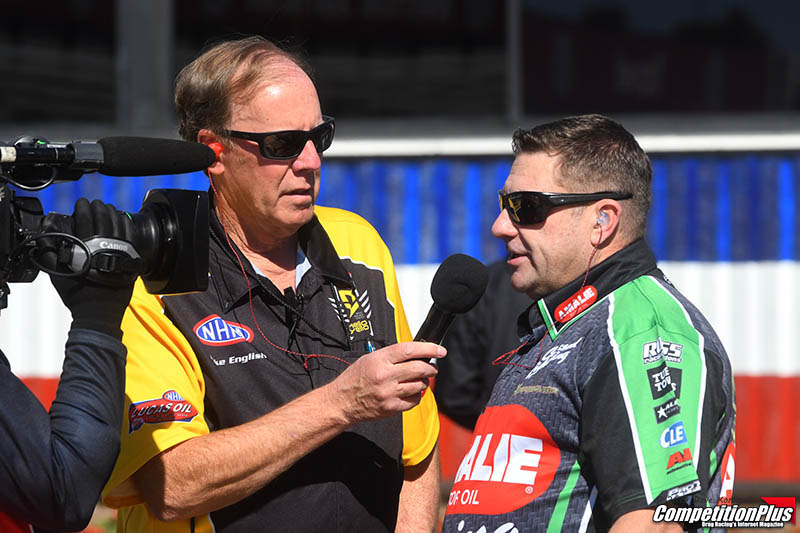NHRA CREW CHIEFS ADJUSTED TO COLD IN PHOENIX

“There’s so much stuff that’s done in the pit first – not tune up wise, but just making sure the car’s prepared for cold weather. That is all the internals and all the rear end. Everything’s really cold,” Wendland said.
Parts and pieces receive special treatment.
“We try big heaters and stuff like that. We try warming it up. I have what they call a Salamander outside,” he said while in his hauler office, going over data Friday. He said he was trying to heat the car’s “guts” to somewhere in the neighborhood of 70-75 degrees. “That’s kind of my minimum to start up [a dragster], because what happens is the clearances all change on everything. The fuel pump gets tighter, so it gets bigger. The clearances between the crankshaft and the engine block, it tightens up,” he said.
“I think about getting 70-90-weight fluid in the rear end, and if it’s 40 degrees comparatively to 80 degrees, it’s heavier. It really is, and so it’s harder to turn.”
For Wendland, “it’s just common sense,” he said. “You know, batteries [in a passenger car] when they get colder, they lose cranking amps. But everything, the oil, everything else is so thick from being that cold, it’s harder to spin. So then you get in it, you let it warm up, and everything, and you go and take a little drive and the minute you back up, you feel like maybe the brakes are on a little bit. So all the rear end fluid and everything else is so cold that it’s having to work against that. You notice also that the ride is different. It’s like it’s bumpier. The shocks, everything acts different.”
Then, when the team takes the car to the staging lanes, it has to make sure not to lose the progress made back in the pit.
“It’s like you warm it up here in the pit, and then we try to cover it up: blankets and all that kind of stuff to retain the heat,” Wendland said. “Another thing it does is it actually changes the mixture of nitro and alcohol. It changes quite a bit. It really falls off. Sometimes that’s a little hard to read. I honestly believe that a 45-degree fuel temperature is going to make more power than 90-degree fuel temperature. You know, you’ve changed the intake temperature of the engine. And so it actually probably makes a little more power. But also, just density-wise, it measures differently. It gets kind of inaccurate with the gauges that we have a little bit. It’s not as accurate, I believe.”
Johnson personally, physically, had a tough time with the brisk conditions. The cold track and the nasty tire shake hurt his back.
Collins, his crew chief, said, “When it shook, it was so violent that it broke the x-frame, the x-member, the lower rear tree, and the tabs on the bellhousing – and Tommy. It broke him.
“It is what it is,” he said. “When it shakes, it’s pretty violent. We were pushing pretty hard.”
But “none of it” shocked Collins, he said. “The track was cold. It was tight. And it’s hard to get under power to get it done.”
One driver who said he didn’t have any problems with the cold weather here or at Pomona was Top Fuel’s Clay Millican. He didn’t fare any higher than sixth Friday, slid to seventh early Saturday, and ended up in the 11th starting position.
But he said, “We were all good. It was just rough for the fans. I hate it when it’s like this because it certainly keeps people from coming to the races - understandably. But the thing is when you have conditions like this, while, granted, you may not see the majority of the cars make it down the track under power, the chances are really good that when they do go, it’s going to be really fast. So it’s one of those deals where it’s nothing we can do about it, but the opportunity to go really fast is certainly there. When it’s cold out, these things make a lot more power. Not that they don’t make a lot already, but they make even more. The problem is the track is so cold it’s hard to get ahold of it.”
So sometimes the decision teeters on the line between whether it’s safe to run the cars or too cold.
“That’s why I say when it’s conditions like this, you’ll either see home runs or strikeouts,” Millican said. “It’s usually not much in between. And that’s kind of what we did at Pomona first round. We ended up being the only pair of Top Fuel cars that didn’t get down the track on Sunday.” Monday – race day – the track temperature was cold.
“We shook. We still made a good run,” he said. “I pedaled it and the car recovered, which was fun. But again, back to that hit-and-miss thing, in the opposite lane, Mike Salinas went 3.68 and 333 miles an hour. So that’s what you’ll get when the conditions are like this.”
Track and national records in all three pro classes remain intact so far this weekend.
Like Robert Hight after taking the No. 1 Funny Car position Saturday, Millican wondered what might happen when the weather pattern changes. Crew chiefs are getting used to the cold weather, but it surely will warm up at some point.
“Exactly. You know, you go to Gainesville, it’s subject to be hot. So at this point, I would be OK with that,” Millican said.
Get the @competitionplus Mobile APP to get your drag racing news quick and easy. - https://t.co/HsiKEmdZXO pic.twitter.com/qpgtrHqnpr
— Competition Plus (@competitionplus) January 4, 2019






































